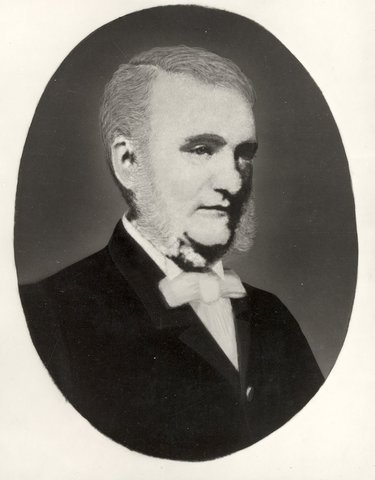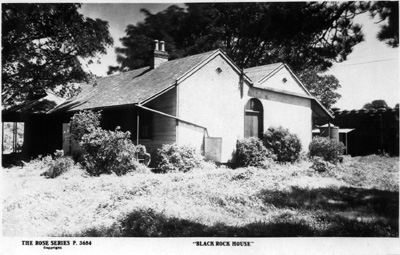Black Rock House
Black Rock House is located at 34 Ebden Avenue, Black Rock, and is a most interesting and important historic building in the City of Bayside. It is classified by the National Trust, registered with the Historic Buildings Council, and is listed on the Register of the national Estate by the Australian Heritage Commission. Built for Charles Hotson Ebden between 1856 and 1858, the house is a unique example of an early colonial holiday residence.
Location
Charles Ebden was born in the Cape of Good Hope in 1811 and, after attending school in England, he completed his studies at the University of Karlsruhe in Germany. He settled in Sydney originally, then came to Melbourne where he attended the first land sales in 1837, and purchased land in Collins Street. He was heavily involved in business and government and represented the Port Phillip District in the Legislative Council of New South Wales during the 1840s.
In 1856, Charles Ebden bought 50 hectares of land in Black Rock and commenced the building of a holiday residence. The name Black Rock House is believed to have come from Blackrock, a resort on Dublin Bay, Eire.
Construction lasted from 1856 to at least 1858. Many materials were imported from overseas but the brown sandstone used in the high walls was quarried on the beach at nearby Quiet Corner. It has not been possible to ascertain the origins of the design of the house or if an architect was involved. Apart from use by Ebden and his family, the house was rented for a time to the Governor of Victoria, Sir Henry Barkly.
Ebden was an active member of the Melbourne Club, serving at various times as Secretary and President, and tragically collapsed and died there in 1867.

B & W photograph, 12.5 x 10cm. This photograph of an earlier portrait shows Charles Hotson Ebden, pastoralist, businessman and politician. Born at the Cape of Good Hope, he became a merchant in Sydney and then a pastoralist. His stock were first to cross the Murray in 1835 and arrived in Melbourne just after the first overlanders Gardiner and Hawdon. Ebden bought land at the first Melbourne land sale in June 1937. In 1856 Ebden purchased 122 acres on the shores of Port Phillip and commenced building Black Rock House.
Black Rock House remained in the possession of the Ebden Family until 1910, when much of the surrounding land was sold and subdivided. The house then had a series of owners and was at times unoccupied. While some of the surrounding land was sold in 1910, Black Rock House remained in the possession of the Ebden Family until 1919, when it was bought by Mr. G. Stubbs who used it as a boarding house for some years.
In 1929, Sandringham Council, despite a report from the City Inspector, recommending demolition as it was deemed unfit for human habitation, decided in favour of preservation because of its historical value. the owner from 1931-1943 was Sir Peter MacCallum, who did much to restore the buildings. From 1943-1972, Black Rock House was owned by Mr. and Mrs. Nutting.
Black Rock House showing side and front view and portion of bluestone wall. Building completed by 1858 and owned by Charles Hotson Ebden, onetime Auditor General and Member for Brighton. He was heavily involved in community affairs. In 1974 Sandringham Council purchased the property for $66,000. Classified by the National Trust and on the Register of the National Estate. Postcard taken by 'The Rose Stereograhs' Armidale, Victoria.
In 1974, Sandringham City Council, aided by a State Government grant, purchased the house and the remaining land for $66,000. The property had originally covered 122 acres and featured and imposing gateway on Beach Road, with a driveway to the house. At the time of purchase, the land had been reduced to that which immediately surrounded the house, and the building themselves had fallen into a poor state of repair. The size of the estate had been reduced to 2,000 square metres, and it had lost its frontage to Beach Road, along with the handsome gateway and extended driveway.
Over the years, many stories have circulated about "Black Rock House or "Ebden's Castle", as it was frequently called. The most prevalent is about ghosts having been seen and heard there during some of the unoccupied periods, but there seems to be no foundation to any of these stories. The second is that the thick castellated stone walls were built to protect the house from "marauding blacks", but records and reminiscences only mention nonviolent contact with small groups of Bunurong. The third story is that there is a tunnel connecting the house with the seashore, supposedly as an escape route in the event of an attack. It seems likely the tunnel did exist, probably to bring stones up from the beach, the extensive searching of the large cellar beneath the house and the cliff face had so far proved fruitless. The only real mystery seems to be that which surround the actual building. No one seems to know why half the house is a stone structure which would be the beginnings of some grand architectural concept, while the second half is timer and brick and of a much more subdued style, albeit a fine example of a colonial house of the period.

Postcard of Black Rock House, 2006
Video produced by Sandringham City Council in 1992.
Additional Resources
